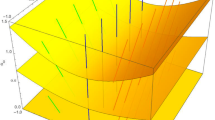Summary
It is shown that, if the Einstein equations are satisfied, the gravitational field invariants must be functions of the Dirac canonical variables only. It is further shown that the non-canonical variablesG 0μ can beexplicitly expressed as functions of the canonical ones (and their first time derivatives) and therefore can be eliminated from the Einstein equations.
Riassunto
Si mostra che, se le equazioni di Einstein sono soddisfatte, gli invarianti del campo gravitazionale devono essere funzioni delle sole variabili canoniche di Dirac. Si mostra inoltre che le variabili non canonicheG 0μ possono essere espresse esplicitamente come funzioni di quelle canoniche (e delle loro prime derivate temporali) e quindi possono essere eliminate dalle equazioni di Einstein.
Similar content being viewed by others
References
P. A. M. Dirac:Proc. Roy. Soc., A246, 333 (1958).
P. A. M. Dirac:Phys. Rev.,114, 924 (1959).
P. G. Bergmann:Nuovo Cimento,3, 1177 (1956).
P. G. Bergmann:Helv. Phys. Acta Suppl.,4, 79 (1956).
E. Newman andP. G. Bergmann:Rev. Mod. Phys.,29, 443 (1957).
A. Komar:Phys. Rev.,111, 1182 (1958).
P. G. Bergmann andA. B. Komar:Status report on the quantization of the gravitational field (preprint, 1960).
A. Peres andN. Rosen:Nuovo Cimento,13, 430 (1959).
For agiven metric, it is not always possible to find four invariants which are functionally independent,e.g. when there exists a group of motions (13). However, we here consider the invariants not as functions of the coordinates, but as functions of the CV, so that it is always possible to find four functionally independent invariants,e.g. the Witten curvature invariants (14), which include no higher than first derivatives ofp mn and second derivatives ofg mn.
A. Komar:Proc. Nat. Acad. Sci.,41, 758 (1955).
L. Witten:Phys. Rev.,113, 357 (1959).
J. L. Anderson:Phys. Rev.,110, 1197 (1958).
R. Arnowitt, S. Deser andC. W. Misner:Phys. Rev.,117, 1595 (1960) and118, 1100 (1960).
Since this paper was submitted for publication, some similar results were obtained byP. G. Bergmann andA. Komar:Phys. Rev. Lett.,4, 432 (1960).
Author information
Authors and Affiliations
Additional information
Partly supported by the U. S. Air Force, through the European Office of the Air Research and Development Command.
Rights and permissions
About this article
Cite this article
Peres, A. Invariants of general relativity. Nuovo Cim 18 (Suppl 1), 32–35 (1960). https://doi.org/10.1007/BF02726035
Received:
Published:
Issue Date:
DOI: https://doi.org/10.1007/BF02726035




